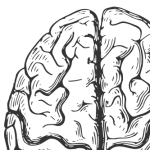 Neuroscience has hit the big time. Every day, popular newspapers, websites and blogs offer up a heady stew of brain-related self-help (neuro-snake oil?) and gee wiz science reporting (neuro-wow?). Some scientists and journalists — perhaps caught up in the neuro-fervor — throw caution to the wind, promising imminent brain-based answers to the kinds of questions that probably predate civilization itself: What is the nature of mind? Why do we feel the way we do? Does each person have a fundamental essence? How can we avoid pain and suffering, and discover joy, creativity, and interpersonal harmony?
Neuroscience has hit the big time. Every day, popular newspapers, websites and blogs offer up a heady stew of brain-related self-help (neuro-snake oil?) and gee wiz science reporting (neuro-wow?). Some scientists and journalists — perhaps caught up in the neuro-fervor — throw caution to the wind, promising imminent brain-based answers to the kinds of questions that probably predate civilization itself: What is the nature of mind? Why do we feel the way we do? Does each person have a fundamental essence? How can we avoid pain and suffering, and discover joy, creativity, and interpersonal harmony?
Predictably, the boldest claims tend to oversimplify and exaggerate scientific results, which are complex, provisional, tentative, and often mutually contradictory. Just as predictably, a backlash ensues. Neuroskeptics and neurocritics coin terms like neurobabble, neurobollocks and neuromania in order to name — and therefore tame — the beast. This of course unhelpfully adds to an ever-growing pile of n(eur)auseating ne(ur)ologisms, including such neurowonders as neuroesthetics, neurotheology, and the dreaded neuromarketing. Since the hype cycle is now measured in twitseconds rather than months or years, a backlash against the backlash seems to be underway already. (See here, here and here, for prominent examples.) Given
- the difficulty of the science,
- the growth of funding,
- the intractability of the never-far-away philosophical issues, and
- the insatiable appetite for both neuro-tidbits and neuro-antacid among the secular educated classes,
the neuro trend is likely to continue for the foreseeable future, like a chattering neuron.
Se we might as well sit back and enjoy the show, right?
In order to make sense of the plots and intrigues in the palace of brain sciences, it is worth contemplating the sheer diversity of traditions that take up residence within its walls. And the paint isn’t even dry on these walls — until very recently, there were almost no undergraduate programs in neuroscience. I entered the field a little over seven years ago. Prior to that I studied physics, and I was only dimly aware of the umbrella term “neuroscience”. Before discovering neural networks I assumed only medical doctors studied the brain.
When I entered grad school one of our professors — also a former physics type — began his course on computational neuroscience with a little “sociology” of the field. He illustrated his description of the fields feeding into neuroscience with a handy little scheme.
And here it is for the wider world to enjoy: I give you the Pentagon of Neuroscience. It’s only half-serious — it is not a systematic characterization of the field, but it can help us to locate and contextualize the neuroscientists, the types of questions they ask, and the methods they use. Until a few years ago, neuroscience culled most of its practitioners from a variety of other departments. In my department we all saw ourselves as misfits and outcasts from our respective fields — united in our interest in mind and brain, but divided in pretty much every other respect!
Yet the clash of cultures that occurs when a biologist talks to a former physicist is the kind of friction that, on a good day, leads to creative sparks. (On a bad day, however, it will lead to much fuming.) With the professionalization of neuroscience and the proliferation of undergraduate programs, I hope this multicultural society does not fall between the cracks of academic fragmentation and specialization. Tunnel vision is unlikely to help us paint an integrated picture of mind, brain and behavior.
The Pentagon of Neuroscience — or Neuragon for short — is a cyclic spectrum diagram, like a color wheel or a musical octave. The cyclic structure means that adjacent points share some similarity along some dimension, and as you move clockwise or counter-clockwise that dimension gradually changes.
Let’s start with the theoretical physicists, mathematicians and computer scientists at the top of the Neuragon. As you move counterclockwise from there, the use of abstract mathematics decreases and the use of computational or numerical mathematics increases, until you reach the biologists. Biologists, in my experience, are not especially comfortable talking about differential equations. But they do need statistics these days. As you move away from the biologists and towards the psychologists and philosophers, the relevance of mathematics vanishes completely. On the upswing of the counterclockwise cycle, the use of verbal methods increases. (My professor somewhat uncharitably referred to the philosophy/theology corner as the “verbal fringe”.) From the practically-minded verbal techniques of counseling psychologists we move up to the most abstract philosophers of mind. Methodologically and temperamentally, analytical philosophers have much in common with mathematicians and computer science. They like to define terms clearly and then allow rigorous logic to do the heavy lifting.
The clockwise movement can be described more simply with a thought experiment. Imagine a mathematician engaged in reflection. She might ask how her mathematical ideas arise in the first place. From here she investigates the philosophy of mind, which describes thought processes abstractly, without reference to neural substrates. Seeking more concrete understanding, she flips through a psychology textbook, which points her in the direction of the brain. Diving into the ocean of neuroscientific facts, she is dismayed by the buzzing confusion of biology and neurochemistry. A far cry from crisp black mathematical symbols on white paper. Seeking to simplify by stepping back and taking a wider, fuzzier view, she seeks solace in computational neuroscience — neurally inspired but simplified models that serve as toy analogies to neural processes. A short hop from mathematical modeling takes her back where she started, contemplating the mysterious connections between mathematical forms and nature.
For simplicity (and for kicks) lets simplify the vertices of the Neuragon, labeling them with Greek letters that connote the fields they denote.
 Neuro-alpha (νρα): This is the abstract, symbolic, whiteboard/pen-and-paper world occupied by mathematicians, theoretical physicists, and computer scientists. Alpha is the first letter of the Greek alphabet, and connotes beginnings, and therefore the clean slate world inhabited by many mathematicians — a world of both invention and discovery. Alpha is related to aleph too — a symbol with a powerful pedigree in mathematics. Alpha-neuroscientists attempt to invent new mathematical and algorithmic techniques to imitate human and animal intelligence.They are not typically interested in alleviating the pain of neurological disorders, and rarely enjoy the mushy world of actual brains. Their scientific orientation is often that of a puzzle-solver. The twist is that these theoreticians invent the puzzles that they then attempt to solve, and can never be sure if all the puzzle pieces will ever fit together.
Neuro-alpha (νρα): This is the abstract, symbolic, whiteboard/pen-and-paper world occupied by mathematicians, theoretical physicists, and computer scientists. Alpha is the first letter of the Greek alphabet, and connotes beginnings, and therefore the clean slate world inhabited by many mathematicians — a world of both invention and discovery. Alpha is related to aleph too — a symbol with a powerful pedigree in mathematics. Alpha-neuroscientists attempt to invent new mathematical and algorithmic techniques to imitate human and animal intelligence.They are not typically interested in alleviating the pain of neurological disorders, and rarely enjoy the mushy world of actual brains. Their scientific orientation is often that of a puzzle-solver. The twist is that these theoreticians invent the puzzles that they then attempt to solve, and can never be sure if all the puzzle pieces will ever fit together.
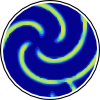 Neuro-lambda (νρλ): I named this corner of the Neuragon after lambda calculus, one of the theoretical foundation stones of computer science. Lambda-neuroscientists are computational neuroscientists like me. We attempt to characterize the brain’s structure and dynamics in computable terms, which can then be fed into a computer for simulation purposes. We share with the Neuro-alphas the toy puzzle-solving attitude, though we try to keep an eye on experimental verifiability. Topographic mappings, spiking models and artificial neuronal networks are unlikely to assist clinical psychiatrists or psychologists any time soon. But even if toy models have nothing to do with real neural dynamics, they can produce fun little patterns like this one:
Neuro-lambda (νρλ): I named this corner of the Neuragon after lambda calculus, one of the theoretical foundation stones of computer science. Lambda-neuroscientists are computational neuroscientists like me. We attempt to characterize the brain’s structure and dynamics in computable terms, which can then be fed into a computer for simulation purposes. We share with the Neuro-alphas the toy puzzle-solving attitude, though we try to keep an eye on experimental verifiability. Topographic mappings, spiking models and artificial neuronal networks are unlikely to assist clinical psychiatrists or psychologists any time soon. But even if toy models have nothing to do with real neural dynamics, they can produce fun little patterns like this one:

 Neuro-chi (νρχ): This is what most people imagine when you tell them you’re studying the brain. White coats, test-tubes, gooey bits of brain, microscopes, electrodes, lab rats… the stuff that keeps science grounded and hands-on. Chi is a letter I associate with the hypothesis-testing side of experimental science, because of the Chi-squared distribution. Also, capital chi is X, which is sometimes used to stand for eXperimental (e.g). The X-Neuroscientists are studying actual brains of animals and humans. Some of them are aiming to help treat diseases and disorders, while others are satisfying their curiosity about brains. They might take some interest in mathematics as a tool, and in psychology or philosophy as overarching schemes, but in my experience they prefer the task of seeing for themselves how the nervous system looks and behaves.
Neuro-chi (νρχ): This is what most people imagine when you tell them you’re studying the brain. White coats, test-tubes, gooey bits of brain, microscopes, electrodes, lab rats… the stuff that keeps science grounded and hands-on. Chi is a letter I associate with the hypothesis-testing side of experimental science, because of the Chi-squared distribution. Also, capital chi is X, which is sometimes used to stand for eXperimental (e.g). The X-Neuroscientists are studying actual brains of animals and humans. Some of them are aiming to help treat diseases and disorders, while others are satisfying their curiosity about brains. They might take some interest in mathematics as a tool, and in psychology or philosophy as overarching schemes, but in my experience they prefer the task of seeing for themselves how the nervous system looks and behaves.
 Neuro-psi (νρψ): Neuropsychologists probably have this on tee shirts by now! You could say that medicine and psychology are the grandmother and mother of neuroscience, respectively. It was the psychologists who brought together people from other fields, piquing their interest in the link between mind, brain and body. I think psychologists and psychiatrists are typically more interested in humans than animals, and are interested in brain facts only if they help with their understanding on higher-level mental phenomena. The kind of social neuroscience that receives the most bouquets and brickbats tend to emanate from the psi-zone.
Neuro-psi (νρψ): Neuropsychologists probably have this on tee shirts by now! You could say that medicine and psychology are the grandmother and mother of neuroscience, respectively. It was the psychologists who brought together people from other fields, piquing their interest in the link between mind, brain and body. I think psychologists and psychiatrists are typically more interested in humans than animals, and are interested in brain facts only if they help with their understanding on higher-level mental phenomena. The kind of social neuroscience that receives the most bouquets and brickbats tend to emanate from the psi-zone.
Neurologists and neurosurgeons might fit somewhere in this neighborhood — perhaps between chi and psi, but interestingly enough, I rarely meet medical doctors — their culture seems a bit removed from academic neuroscience, which is unfortunate. I chose to reference to Maslow’s hierarchy of needs because it is a well-known psychological systematization of higher-level concepts. Many neuroscientists shy away from terms like “love” or “esteem”, but those who study behavior often find it useful to think of humans and animals (and artificial systems) as having to decide between several goals — food, security, pain avoidance, etc. In doing so we have to construct our own operational hierarchies of needs, desires or drives.
And finally (without pausing to talk about William James — a brilliant scholar and physician who bridged philosophy and psychology) we come to…
 Neuro-phi (νρφ): The neuro-phis are the ones who are best qualified to say “fie on neurobabble”. Philosophy is often seen in the west as the mother of all disciplines, and the final arbiter of truth and cultural importance. There is a great deal of truth in this, but a careful look at the history of science reminds us that educated elites who worked with their tongues and their pens rely for much of their intellectual (and literal) fuel on people who rarely feature in the annals of Great Men: “hunter-gatherers, peasant farmers, sailors, miners, blacksmiths, folk healers“. Nevertheless, philosophy is a key repository of abstract, high-level thinking on all topics known to humanity, and philosophers are adept at keeping us neuroscientists on our toes — not so much by answering questions as by asking them. Philosophers help us maintain a healthy skepticism of trendy scientific “facts”, and show us how to argue tenaciously yet rationally. (Their children grow up to become good neuroscientists too, apparently.) In my opinion neurophilosophy can sometimes border on the absurd, but I also think scientists could learn a lot from the care with which many philosophers interpret experimental findings and probe their connections with the mind.
Neuro-phi (νρφ): The neuro-phis are the ones who are best qualified to say “fie on neurobabble”. Philosophy is often seen in the west as the mother of all disciplines, and the final arbiter of truth and cultural importance. There is a great deal of truth in this, but a careful look at the history of science reminds us that educated elites who worked with their tongues and their pens rely for much of their intellectual (and literal) fuel on people who rarely feature in the annals of Great Men: “hunter-gatherers, peasant farmers, sailors, miners, blacksmiths, folk healers“. Nevertheless, philosophy is a key repository of abstract, high-level thinking on all topics known to humanity, and philosophers are adept at keeping us neuroscientists on our toes — not so much by answering questions as by asking them. Philosophers help us maintain a healthy skepticism of trendy scientific “facts”, and show us how to argue tenaciously yet rationally. (Their children grow up to become good neuroscientists too, apparently.) In my opinion neurophilosophy can sometimes border on the absurd, but I also think scientists could learn a lot from the care with which many philosophers interpret experimental findings and probe their connections with the mind.
_____________________
Notes:
- The astute reader will have noted by now that I have not used the word “cognitive” anywhere in the infographic or in the text (except in this sentence). I will leave the task of placing cog sci on the Neuragon as an exercise for the reader.
- The even more astute reader will note that I have oriented the brain cartoon at the center of the Neuragon so that (1) the frontal areas of the brain face the “blue sky” thinking of mathematics and theoretical physics, (2) the left side of the brain faces the more mathematical/analytical fields, (3) the right side of the brain faces the more holistic fields, and (4) the visual areas at the back of the brain are “keeping an eye” on the red zone of experimentation. More visual puns may well reveal themselves.
- Images were created in Inkscape. Clipart was derived from wikipedia and from the clipart repository of the Educational Technology Clearinghouse.
- I must also thank my good friend Madhu M Chandran for triggering all this by bringing up the concept of an epistemological circle. That’s what reminded me of my professor’s pentagon.
EDIT: The ‘infographic’ doesn’t work any more since the way browsers parse svg files has changed. Not sure how to fix it. Sorry! 🙂

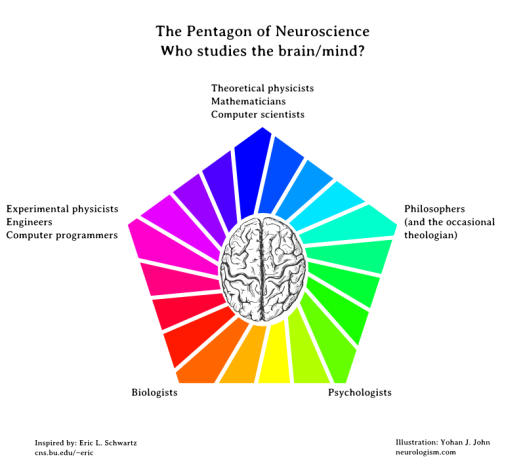
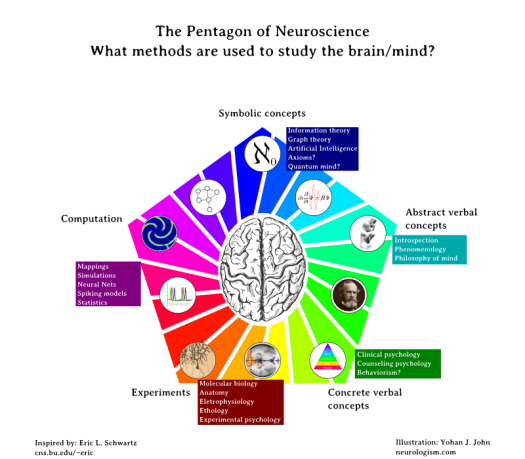
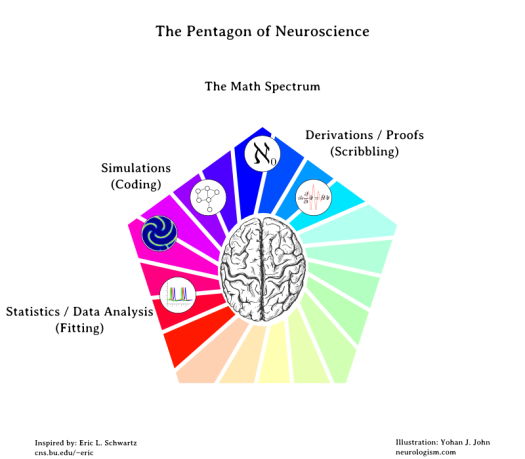
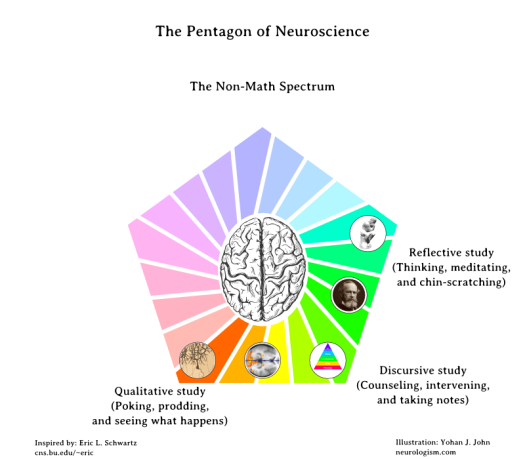
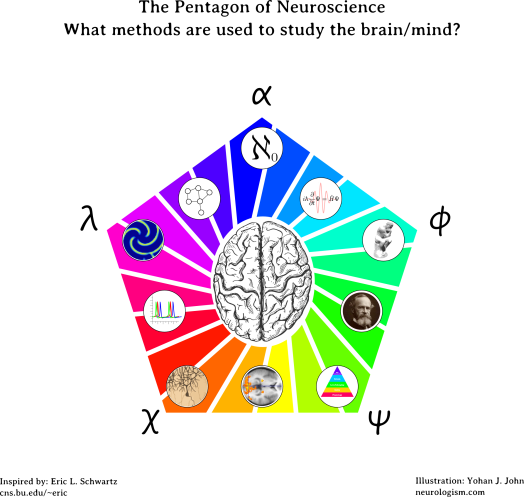
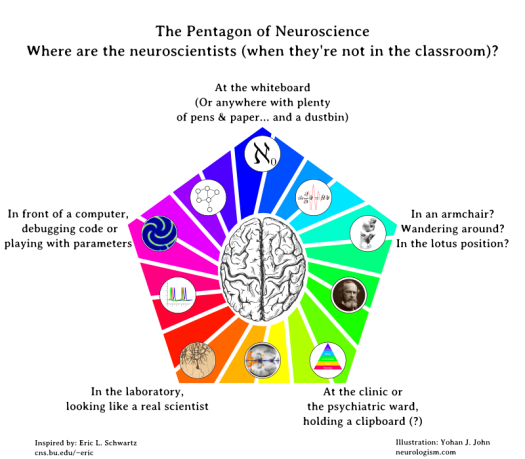
Leave a Reply